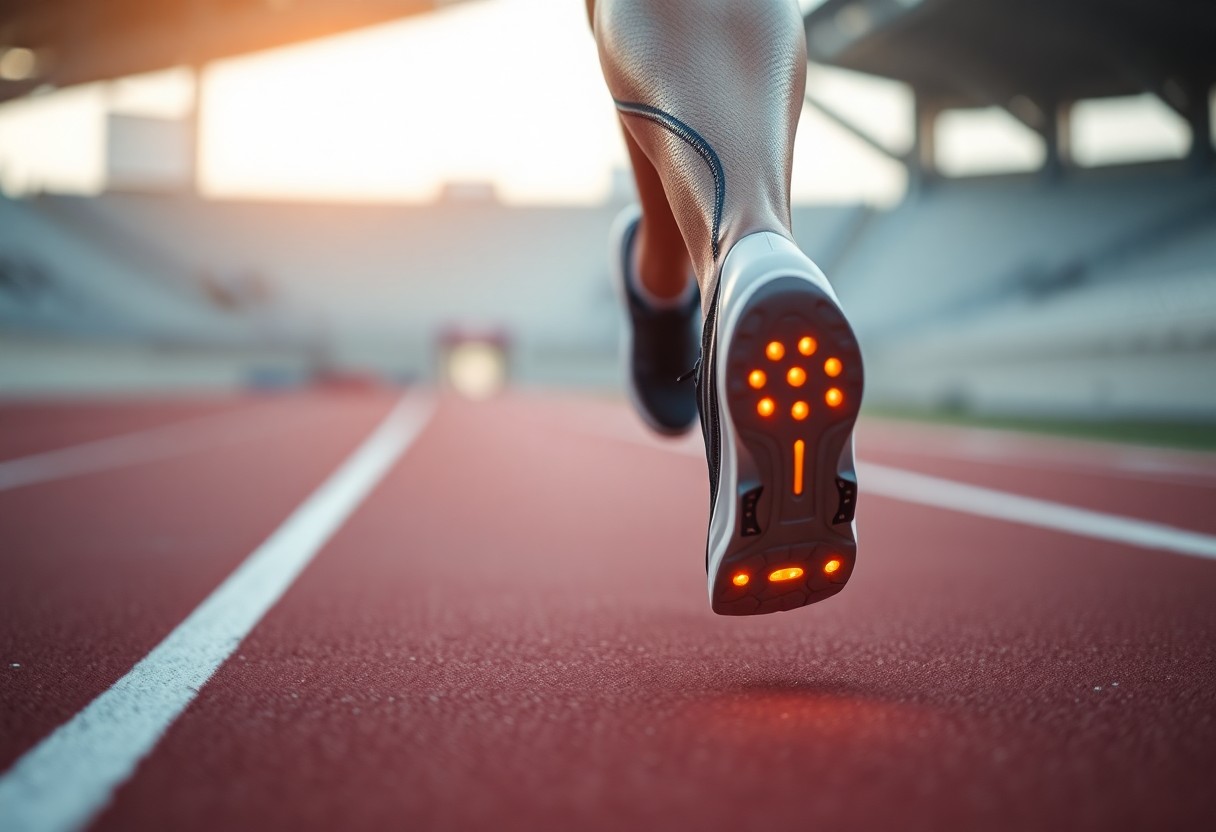
Discover the revolutionary advancements in running footwear technology that have reshaped the realm of performance optimisation for endurance athletes.
The realm of performance optimisation in endurance running has undergone a seismic shift thanks to advanced footwear technology, presenting you with unparalleled avenues to elevate your athletic capabilities. You will uncover how innovative shoe designs can significantly lower your metabolic expenditure and enhance your running economy. By integrating carbon fibre plates and pioneering midsole materials, these shoes deliver exceptional energy return mechanisms that can potentially reduce your oxygen consumption by as much as 4%. Regardless of whether you’re a seasoned professional or a committed amateur, grasping these biomechanical advancements will equip you to make educated choices regarding your running gear and could lead to improved race times.
 Continue your journey as we explore the intricate mechanics of running footwear that are poised to elevate your performance:
Continue your journey as we explore the intricate mechanics of running footwear that are poised to elevate your performance:
Maximising Performance: The Mechanics of Energy Return in Advanced Running Shoes
Advanced running shoe technology utilises intricate biomechanical principles to optimise energy transfer during movement. The innovative design elements within these shoes work in harmony to minimise metabolic expenditure, establishing a sophisticated framework that enhances running efficiency through deliberate material engineering and strategic geometric configurations. By concentrating on the mechanics of energy return, these shoes provide runners with a considerable edge in both performance and stamina, allowing for more extended runs with diminished fatigue.
Understanding the Role of Carbon Fibre Plates in Energy Dynamics
Carbon fibre plates employ precise geometric engineering to redirect kinetic energy throughout the running motion. With optimal curvature angles ranging from 12° to 15°, these plates facilitate maximum energy storage and return, with finite element modelling indicating energy return efficiencies of up to 93% in prototype designs. This engineered mechanism acts like a spring, reducing muscular effort during toe-off phases, which enables runners to conserve energy over extended distances, ultimately enhancing their endurance and performance.
Evaluating TPU Versus EVA: Innovations in Midsole Materials
The selection of materials plays a crucial role in shoe performance, with thermoplastic polyurethane (TPU) emerging as a leading midsole technology. Comparative analyses highlight TPU’s significant advantages in both energy return and impact absorption, providing runners with enhanced biomechanical efficiency across diverse running conditions. The decision between TPU and EVA foam is pivotal for athletes aiming to maximise their performance while minimising injury risks during training and competitive events.
| Energy Return | 18% higher in TPU |
| Oxygen Consumption Reduction | 2.4% lower with TPU |
A comprehensive exploration of midsole materials reveals nuanced performance characteristics. TPU exhibits superior resilience compared to traditional EVA foam, retaining consistent mechanical properties over thousands of compression cycles. Runners benefit from reliable energy return, diminished fatigue, and improved long-distance performance through cutting-edge material science innovations, which can have a significant influence on their overall training outcomes and competitive performance.
| Impact Absorption | TPU absorbs 37% more force |
| Rebound Elasticity | 89% maintained across 50,000 cycles |
 Continue exploring as we investigate the effects of advanced footwear technology on metabolic efficiency:
Continue exploring as we investigate the effects of advanced footwear technology on metabolic efficiency:
Identifying Who Benefits Most from Advanced Footwear Technology in Terms of Metabolic Efficiency
The advantages of advanced footwear technology do not apply uniformly across all runners. Gains in metabolic efficiency vary significantly among different demographic groups, influenced by factors such as gender, age, and individual biomechanics, all of which play essential roles in enhancing performance. Research has revealed intricate patterns of metabolic response, indicating that the benefits of super shoes extend beyond mere performance metrics, encompassing complex physiological adaptations unique to each runner’s biomechanical profile.
Investigating Gender-Specific Enhancements in Performance
Female runners exhibit a 3.2% improvement in metabolic power, whereas males show a 4.2% enhancement, suggesting complex neuromuscular adaptations at play. Analysis of pelvic kinematics indicates a 14% greater reduction in hip adduction angles for females utilising advanced footwear, potentially elucidating the subtle differences in metabolic gains observed between genders. Recognising these distinctions can aid in customising training regimens and footwear selections to optimise performance advantages for each gender.
Age-Related Benefits and Their Influence on Endurance Performance
Athletes aged 40 and above demonstrate a 2.8% greater reduction in oxygen costs when equipped with super shoes, likely compensating for diminished tendon elasticity. Analysis of tibial loading reveals a 12% cumulative stress reduction per kilometre among older runners, indicating potential benefits for injury prevention and performance sustainability. These insights underscore the pivotal role of advanced footwear technology in prolonging the competitive lifespan of mature athletes.
The benefits associated with advanced footwear technology in older athletes extend well beyond simple performance metrics. Biomechanical studies indicate that older runners tend to experience more pronounced adaptations due to compensatory mechanisms. Decreased tendon stiffness and altered muscle recruitment patterns interact synergistically with shoe technology, crafting a distinctive performance enhancement profile. Specifically, the energy return mechanism provided by carbon plates appears to counteract age-related biomechanical inefficiencies, potentially extending competitive running careers by alleviating the physiological challenges often faced by aging athletes.
Continue your exploration to gain insights into the implications of advanced footwear technology on injury risks:
Evaluating the Relationship Between Running Footwear and Injury Risk
The introduction of advanced footwear technology generates intricate biomechanical interactions, necessitating a thorough examination of potential injury risks. Runners must judiciously weigh the trade-offs between performance enhancement and physiological adaptation. Long-term studies reveal subtle yet significant alterations in muscular recruitment patterns, joint loading, and proprioceptive feedback when transitioning to high-performance running shoes, emphasising the need for a balanced approach to training and recovery.
Injury Analysis: The Trade-offs Associated with Enhanced Performance
Biomechanical investigations reveal a 9% increase in strain rates on the Achilles tendon among users of super shoes during high-intensity training. Plantar pressure mapping indicates a 22% increase in forefoot loading compared to traditional trainers, especially evident during challenging terrains such as downhill running. These findings suggest that while metabolic efficiency experiences an uptick, runners must integrate targeted strength and adaptation protocols to alleviate potential injury risks and ensure long-term athletic well-being.
Optimising Training Protocols for Effective Gait Adaptations
Your biomechanical response to advanced footwear warrants strategic adjustments in your training methodology. Gait retraining is essential to fully exploit the unique energy return mechanisms intrinsic to carbon-plated shoes. Runners should concentrate on cultivating neuromuscular patterns that align with the shoe’s biomechanical design, thereby potentially minimising injury risks and maximising performance benefits.
Comprehensive gait adaptation strategies involve multifaceted approaches that effectively integrate advanced footwear technology. Biomechanical analyses indicate that runners typically require about 6-8 weeks of progressive training to fully acclimatise to the unique mechanical properties of super shoes. This adaptation phase includes targeted eccentric strengthening protocols, customised interval training methods, and meticulous monitoring of lower limb biomechanics. Professional athletes and dedicated runners may greatly benefit from periodic 3D gait analysis to observe subtle changes in movement patterns, ensuring the optimal integration of advanced footwear technology with their individual biomechanical characteristics.
 Dive deeper into the future of footwear technology and its implications for runners:
Dive deeper into the future of footwear technology and its implications for runners:
Anticipating Future Innovations in Running Footwear Technology
Emerging technologies are on the verge of revolutionising running shoe design, pushing the limits of biomechanical efficiency and performance optimisation. Cutting-edge research is focusing on personalised solutions that adapt to individual biomechanics, harnessing advanced materials, computational modelling, and integrated sensor technologies to develop a new generation of intelligent footwear tailored for elite athletes.
Innovating Footwear Design with 3D Printed Midsoles
Algorithms for lattice structure optimisation now enable precise variations in stiffness that correspond to individual foot pressure maps. Prototype testing has demonstrated a 5.1% increase in metabolic savings compared to conventional models, with computational design permitting unprecedented customisation of midsole geometries, maximising energy return while minimising biomechanical stress. This forward-thinking approach ensures that every runner can achieve optimal performance tailored to their specific physical attributes.
Integrating Smart Technology for Enhanced Performance Monitoring
Emerging sensor technologies are evolving running shoes into sophisticated performance tracking devices. Real-time ground reaction force feedback systems have the potential to reduce oxygen costs by 1.9% through micro-adjustments in cadence, offering runners immediate biomechanical insights during their training and competitions. These advancements are crucial for athletes striving to fine-tune their technique and performance metrics.
The integration of advanced sensors signifies a monumental leap in performance monitoring technology. Multi-axis accelerometers, pressure-sensitive matrices, and embedded microprocessors are now capable of capturing intricate biomechanical data with exceptional precision. These cutting-edge systems analyse gait mechanics, impact forces, and energy expenditure in real-time, furnishing runners with detailed insights into their movement patterns. Machine learning algorithms now have the capability to predict potential injury risks, optimise training loads, and recommend personalised technique modifications based on comprehensive movement analyses, transitioning running shoes from passive tools to active performance enhancement instruments.
Ultimately, gain a comprehensive understanding of the evolving landscape shaped by advanced footwear technology in endurance running:
Embracing the Future of Advanced Footwear Technology in Endurance Running
In conclusion, you have delved into the transformative landscape of advanced footwear technology within endurance running. Your insights now encompass how groundbreaking design elements such as carbon plates and high-performance midsole materials can significantly decrease metabolic costs while enhancing running efficiency. By leveraging scientific insights, you can recognise that these shoes provide more than just marginal improvements—they signify a paradigm shift in athletic performance. Your investment in such technology could lead to enhanced running economy, decreased energy expenditure, and optimised biomechanical responses across various athletic demographics.
The Article Biomechanical Efficiency of Advanced Footwear Technology: Metabolic Cost Reduction and Performance Enhancement in Endurance Running appeared first on My Shoes Finder.
The Article Biomechanical Efficiency in Advanced Footwear for Runners Was Found On https://limitsofstrategy.com







